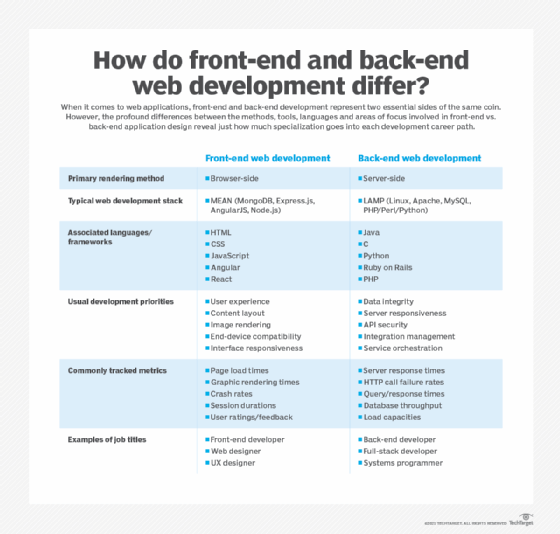
James Thew - Fotolia
The difference between front-end and back-end developers
While front-end and back-end application development are two parts of a greater whole, the specifics of each career present some stark differences between them.
Software applications used to be built with server-side programming languages and databases, such as Java and MySQL, that were built specifically for desktop-based clients. Because of the static nature of both desktops and software, the back-end structure of applications took infinitely higher precedence over the user interface and other front-end design work. However, the advent of modern web browsers, web applications and mobile computing caused front-end application design to become a top-of-mind concern for development teams.
There is no doubt that the back-end integrity of an application is just as -- if not more -- important as ever when it comes to modern application development. However, the front-end has risen to such prominence that developers have managed to create an entirely independent career path and market around it, boasting a diverse ecosystem of jobs, design styles and tools made just for front-facing development.
But what makes the work and career of a front-end developer different than their back-end colleagues? In this piece, we'll look at some of the specific coding skills, tools and challenges that make these two ends of the development spectrum so unique. In addition, we'll quickly review some of the major changes that are having -- or soon will have -- a big impact on these fields.
Front-end development
Front-end developers focus primarily on the user experience, using their coding and design skills to measure and improve what an application's users see, hear and interact with. Often, this begets a drive to design apps that are intuitive, functional and elegant. On top of that, emerging trends around front-end design have both elevated the sophistication of what developers can accomplish and complicated what used to be a relatively simple endeavor.

By no means do front-end developers totally ignore back-end systems, databases, components and functions. On the contrary, the back end of an application must be adequately scalable and performant for the front end to load quickly and behave correctly. These types of programmers will likely not concern themselves with all the exact details of back-end processes. However, at a minimum, they should be capable of determining whether issues with the interface are a result of front-end or back-end errors. For instance, if a web application page is broken, a front-end developer should be able to identify whether the problem's source is a front-end plugin or a back-end database.
The biggest shift in front-end development over the past decade has been the explosion of mobile applications and smart devices. With the device landscape getting more fragmented every year, front-end developers must deliver an outstanding experience no matter which device the user consumes the application from.
While JavaScript has traditionally ruled the front-end in terms of languages, frameworks such as jQuery and Angular have gained prominence as of late. As organizations continue to rabidly pursue quicker application development, and front-end developers do more exciting and creative things they enjoy, these adoption trends are likely to keep growing rapidly.
Back-end development
Back-end developers are all about the behind-the-scenes architecture. Often dealing with servers and databases, their main concern is whether the architecture can hold up under the weight of a sudden spike in traffic. Back-end developers build for scale, are always thinking of optimizing the system architecture and they regularly measure server and database performance metrics.
The complexity of managing the back-end stack has grown exponentially over the past decade. The emergence of technologies like containers, Kubernetes, NoSQL, full-text search engines and service meshes have completely changed the way applications share and consume data. Additionally, open source tooling -- such as Prometheus, Istio, Jaeger, Helm and Spinnaker-- has changed the face of back-end development tools.
Another trend in the market that impacts back-end development is the emergence of low-code development platforms. These platforms handle rendering of the applications on any device and streamline back-end operations, like database management, and even enable serverless computing. These platforms can be a great benefit to qualified developers, but they are now faced with the challenging task of managing and securing apps made by business-side citizen developers.







